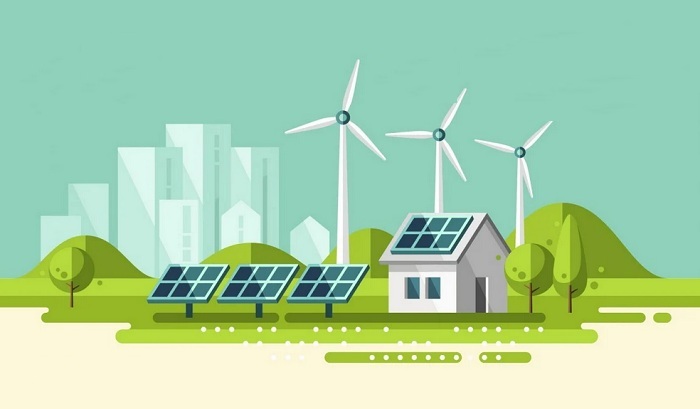A report by BloombergNEF titled “New Energy Outlook: India” reveals that India’s transition to a net-zero economy by 2050 presents an investment opportunity exceeding $12.7 trillion. The report outlines two scenarios for India’s energy system, assessing the opportunities and challenges associated with the country’s transition. The Economic Transition Scenario (ETS) focuses on an economics-driven transition, striving to limit global temperature rise to 2.6 degrees Celsius by 2050. While it makes significant strides toward energy independence and decarbonization, it must achieve these goals by 2050. In contrast, the Net Zero Scenario (NZS) envisions greater government support and private sector investments, aiming for net-zero emissions by 2050 without relying on unproven technologies. It also enables India to attain its energy independence goal by mid-century at the lowest cost.
India has already made headway in decarbonizing its power sector, primarily due to its clean energy auction programs. Between 2018 and 2022, India added 53 gigawatts of solar and wind capacity, with 16 gigawatts of utility-scale solar added in 2022 alone. However, solar and wind power account for less than a quarter of the total power generation capacity, with coal dominating the remainder. Consequently, India’s electricity generation remains a major source of emissions. BNEF’s analysis suggests that maximizing the deployment of solar and wind energy, supplemented by nuclear energy storage and carbon capture and storage (CCS) for thermal power plants, represents the most cost-effective approach for India to increase electricity accessibility while reducing the carbon footprint of its energy production.
The New wind and solar power plants in India have already achieved a lower levelized cost of electricity generation compared to new thermal power plants. By the mid-2030s, the cost of electricity generation from new solar and wind power plants is expected to be cheaper than the operational costs of existing coal plants.
In the NZS, the combined installed capacity of wind and solar power experiences a substantial 30-fold expansion, increasing from 99 gigawatts in 2021 to 2,998 gigawatts by 2050. Wind and solar energy account for 80% of electricity generation in 2050, with nuclear contributing 9%. The remainder is sourced from hydro, biomass, hydrogen-fired thermal plants, and thermal power plants equipped with CCS. Even in the ETS, BNEF’s baseline scenario, solar power and wind power become the primary sources of electricity supply, making up 67% of electricity generated in 2050.
Rohit Gadre, India Research Senior Associate at BNEF, emphasizes the need for India to enhance grid flexibility to integrate the substantial capacities of variable wind and solar power. Multiple solutions, including batteries, pumped hydro storage, and peaker gas plants, can coexist to achieve this goal.
For India to remain on the path to net zero, energy supply and demand investments must reach $7.6 trillion between 2022 and 2050 in the ETS scenario, averaging $262 billion annually. In the NZS, investment levels need to be 1.7 times higher, with an annual average of $438 billion (equivalent to approximately 5% of projected GDP) and a total of $12.7 trillion by 2050. Investment in fossil-fuel power decreases from $317 billion in the ETS to $142 billion in the NZS. To mitigate emissions from remaining fossil fuel use in the NZS, India requires $870 billion for CCS. Electric vehicle (EV) sales account for a significant portion of energy demand investment in both scenarios, with $3.9 trillion allocated for EV deployment in the NZS.
Komal Kareer, India Research Associate at BNEF, highlights the necessity for bold policy efforts by state and national governments to achieve a zero-emission vehicle fleet by 2050. Falling battery costs are expected to accelerate EV adoption beyond 2030, fostering local manufacturing by automobile and battery companies.
Shantanu Jaiswal, Head of India Research at BNEF, asserts that India can substantially reduce its reliance on fossil fuel imports by its centennial in 2047. This can be achieved by expediting the deployment of mature, clean technologies such as solar, wind, and electric vehicles, creating domestic economic opportunities, reducing emissions, and fortifying energy security.
Addressing the burgeoning industrial emissions in India is crucial, particularly as they are projected to surpass emissions from the power sector by the early 2040s. The growth of industries like Steel, aluminum, petrochemicals, and cement drives this rise. As India’s largest emitting industrial subsector, Steel is expected to see emissions nearly triple between 2021 and 2050, accompanied by a similar increase in coal consumption for steelmaking. The cement industry’s coal usage is also set to grow fivefold by 2050, resulting in a fivefold increase in emissions from this sector.
Clean hydrogen and CCS technologies play pivotal roles in combating these industrial emissions. According to BNEF’s NZS, clean hydrogen usage in steel production can contribute 54% of cumulative emissions reduction between 2022 and 2050. Likewise, CCS is instrumental in eliminating 56% of cumulative emissions from cement production.
Under the NZS, India’s industrial sector emissions peaked in 2031. Then, they experienced a significant decline in the mid-2030s due to the increased use of hydrogen and carbon capture technologies in Steel, cement, and petrochemical production. The demand for hydrogen surges, primarily driven by the adoption of hydrogen-fired direct-reduction furnaces in the steel industry. In this scenario, hydrogen production from renewables via grid-connected electrolyzers will become the dominant pathway for India by 2050, replacing the current reliance on hydrogen produced from unabated fossil fuels.
It is worth noting that India’s current Nationally Determined Contributions (NDCs) suggest that energy-related emissions in 2030 would be 31% higher than 2019 levels. However, BNEF’s ETS scenario estimates a 22% increase in energy-related emissions in 2030 compared to 2019, indicating potential improvements beyond the current NDCs. The NZS scenario, on the other hand, requires a 9% reduction in energy-related emissions in 2030 compared to 2019 levels, underscoring the imperative of accelerated deployment of mature clean technologies.





































